Bulawayo
It's not difficult to see why Bulawayo became the favorite home town of many, if not most, of the British colonialists during Zimbabwe's time as Southern Rhodesia. It certainly is a very pleasant place.
Having the layout of a typical mid-west US town, wide streets and pavements in a simple grid formation, low rise buildings, parking for all the cars that might need it, a spacious City Hall, and room for everyone with public parks dotted all around (even a 50-metre swimming pool). It's easy to spend quite a while here. And there's plenty to see further afield as well.
I left Great Zimbabwe after about four days, spent another day in Masvingo, and headed here along very pleasant empty roads through more lush Zimbabwean countryside in glorious weather. Then turned south to spend some time in the Matobo National Park.
It's not a particularly notable park by African standards but is supposed to be the most visited park in the country. That's probably because it's close to Bulawayo where a good proportion of Zimbabwe's population lives. And the scenery does have some interesting features, namely more 'balancing boulders' and 'whaleback boulders' which seem to be a significant part of the volcanic landscape in these parts. And kept me there for three days.
So some photos:

On the way out of Bulawayo to Matobo NP is this sign. The first I'd seen in Africa, I think, bearing a traditional regional name.
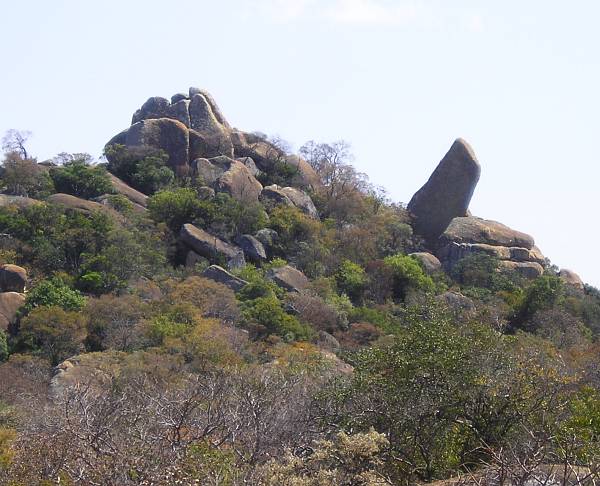




These teetering tons of old stones are all over the place, and I've decided that having a crash helmet to hand when out and about in this countryside is quite an advantage, safety-wise.








Cecil Rhodes, who gave his name to what was then 'Rhodesia', is buried in this park and this is one of his favourite viewpoints.

He called it 'The View of the World'.
To me, along with other similar scenes in other places in the world, it certainly looks like this was one of planet Earth's busiest boiler houses and engine rooms during its fiery formation.
Rhodes built a railway line here so that "the people of Bulawayo may enjoy the Matopos from Saturday to Monday."
This is the station and what remains of that line.


The station sign just about says "The Matopos," the name of this part of the park.
Clearly Rhodes' "Saturday to Monday" stipulation didn't provide enough passenger journeys to make the line a going concern as it closed in 1948 after only forty five years in service.
Here's a photo of a photo hanging in the Bulayawo Railway Museum, of the station in 1935. (Reflection of a window in the glass).

Also in the park is a shrine to The Memorable Order of Tin Hats, or MOTHS, which I had vaguely heard of once, so it was interesting to read about it on a plaque at the site.
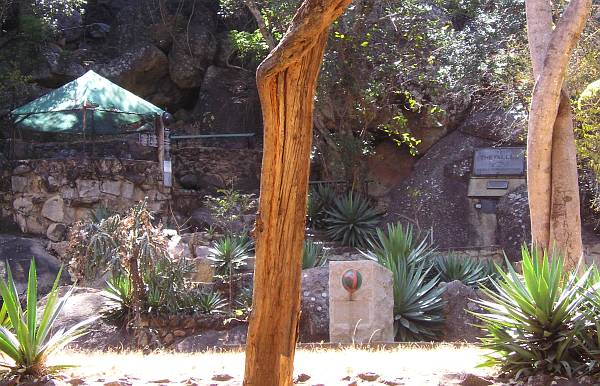
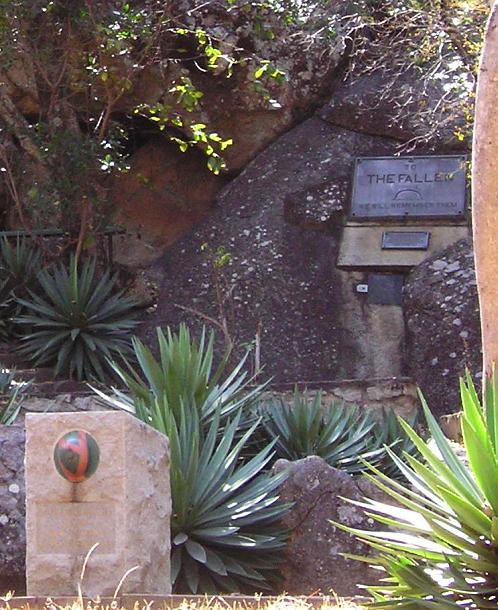
The MOTHS shrine. MOTHS was founded in 1927 to help ex-servicemen from World War One, this shrine consecrated in 1947.
Back in Bulawayo, this is the Cape To Cairo Pub on the main crossroads opposite City Hall.


If it's only 4,650 miles from Cairo to Cape Town via Bulawayo, why is it taking me so long to get there?
Because it's a wonderful continent, that's why!
And also because, I came in from Cairo on the Cape Town road (from Masvingo and Mozambique), not the Cairo road. And the road that I'll be leaving on for Cape Town is the one behind the camera (to the Kalahari and Okavango Delta) not the Cape Town road. (I did say that maps of Africa are a movable feast, and so are the routes).
So, Bulawayo was once firmly on the 'Cairo to Cape Town Route', which may raise the question as to why, very sadly, it isn't nowadays. Coincidentally, I read a piece in a Zimbabwean newspaper last week that leads me to the following ramble.
This is my second visit to Zimbabwe, the first was in 2001 when I spent a little time in book shops and newspaper offices in Harare, gleaning information on the real situation here. (You may remember that the British press was reporting at that time that Harare newspaper offices were being raided by police and army and set alight on a daily, or maybe weekly, basis. Well, I remember the tea in the office being very good).
Beforehand I had read, buried deeply in tiny corners of a British newspaper or two, snippets that raised my curiosity about what was actually happening in the country during the early 2000s and the hand that 'western' interests had in those events. And it was an interesting education on my 2001 visit to Harare to say the least. I'll just say that if your opinion on what has been going on in Zimbabwe over the last ten years has been informed by reading and watching the British news media, then you may hold the precise opinions that western interests in Zimbabwe want you to have, which is the opposite of the opinions that I hold and is why I am here again, enjoying the country. (Yes, terrible things did happen here, and similar events continue today in Sudan for instance. But misrepresentation of Africa in western media is endemic).
I'll finish this bit by paraphrasing what was in that newspaper last week. It was written by a visiting British journalist. (Yes, a British journalist being published in a Zimbabwe newspaper, an impossibility according to the mainstream media back home). She was here during the World Cup to report on the masses of travellers that would be passing through the country on their way to South Africa, and to find out what they thought about Zimbabwe.
Well, she found none. Which is what she thought might happen. She writes: ..... why has everyone diverted through Tanzania and Mozambique? Or through Zambia and Botswana? Why has no one come through Zimbabwe? The streets are safe, the people cheerful, polite and welcoming, the weather wonderful, shelves full, souvenirs plentiful, hotels smart with plenty of rooms, opportunities for sightseeing endless.......etc etc. You get the idea.
And her answer is simple - because of the way the country has been heavily misrepresented in the western media for so long.
So, if you're planning your East Africa journey don't spend time plotting a route to avoid this country, just go through it. You won't be disappointed. And as you can see from the picture above, there's plenty of room, sunshine, and bars for everyone. And, moreover, what little traffic there is drives on the left, as traffic ought to - what more could you want?
I had lunch in the Cape To Cairo. The inside looks as though it was built in the pioneer days, although it says 1931 above the door. Around the walls are photos of early settler times, including an impressive picture of the Harare - Bulawayo passenger and mail coach. Arriving outside the Post Office, it's a typical wild-west type stage coach pulled by a team of eight huge horses. The whole thing looked longer than any freight truck I've seen on the roads so far. Now that must have been real adventure travelling!
And there was good South African jazz playing in the bar - Abdullah Ibrahim.
For the jewel in the crown of these parts, there's the Hillside Road Dams in the south of Bulawayo. A neat little community park next to the main dam, with smart bistro restaurant (with internet when the power's on) and 'tuck shop', all developed out of a derelict river-side area over a period of three or four years by the voluntary efforts of the Hillside Road community. (Hillside Road being the main N - S thoroughfare on the eastern side of Bulawayo).
Probably, only residents of a certain other Hillside Road will be interested in any of this.......

The Hillside Dam.

Picnic area.

The cafe.

Dam wall at the far end.
(The real name is Hillside Dams - I made up the 'Hillside Road Dams' - just for effect)

One of Rhodes' top priorities in Southern Rhodesia (even encouraged in his will) was irrigation. Consequently this part of the country at least, including Matobo National Park, is dotted with dammed-up rivers all over the place, built a hundred years or so ago so that water could easily be extracted from all those rivers. The result today, as well as this little community park, is a chronic lack of water in Bulawayo, with insufficient financial resource to relieve it.
So a little correction to a previous paragraph, there's not quite enough water here for everyone.
There's another jewel in the crown if you're of the railway persuasion - the Bulawayo Railway Museum.
This is a huge area of old railway engines, paraphanalia and memorabilia spread out across numerous tracks in an old sidings, some under cover. It takes a long time to see it all as you have to walk up and down all the rolling stock to get across the tracks, unless you're able to climb over or clamber under the couplings between all the engines and carriages.
A lot of it is claimed to be in working order, other stock is clearly derelict and a little sad looking.
I think there's at least one reader interested in this wonderful stuff, so some more photos:

A little one to start with, 'Rhodesia No.1'.

This is the biggest steam locomotive I've ever seen. Fourteen axles. It's a Beyer-Garratt, made in England according to the curator, but I've never seen one before, nor in any model shop.
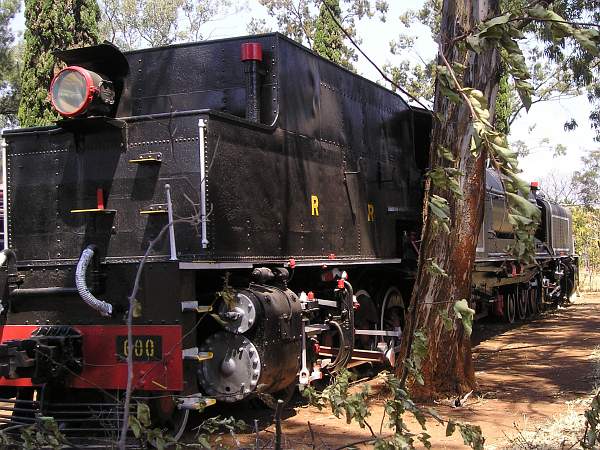
The other side of it. It's like two separate locos, articulated, and sharing a common boiler and fire in the middle. Water tank at one end, coal bunker at the other. This one claimed to be in working condition.

A poster of emotive times past.

Inside Cecil Rhodes' personal carriage. This is particularly well preserved. Also well preserved in a separate display is a complete set of furnishings, china and silverware used in trains during a royal visit to Rhodesia in the 1950s.
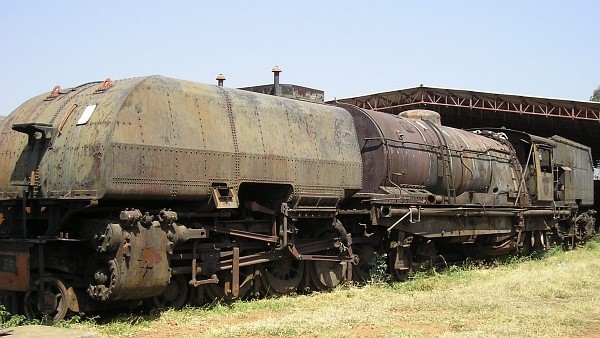
Another Beyer-Garratt, not in working condition but mostly complete by the looks of it.

And another - who'll start the bidding?? - not complete, the water tank removed I think.

More stuff in the out-doors junk yard.


And a couple more preserved in-doors but with window box growing in the sunshine.
This was quite an amazing place, and probably sees many a day with absolutely no visitors, although it comes highly recommended as a place to see. There's quite a collection of telecoms stuff, old valve-operated line testers and a few old mechanical facsimile machines, the ones with the large rotating drum that take about half an hour to send a small picture. Don't know why Rhodesia Railways would have wanted all those. And quite a large room stuffed full with old railway books - it was opened specially for me so probably hardly ever sees the light of day.
Now, will try to find some motorbikes to photograph.
